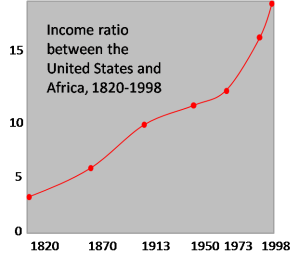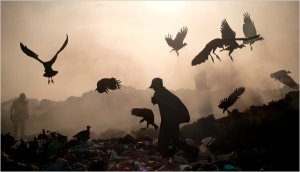Living off garbage: the future is now
Humans fighting each other over filthy scraps of garbage just to stay alive. In my book, Requiem of the Human Soul, the hero Eusebio is disgusted to see this happening in the squalid dirt of Shaktigarh, a city in India in the late 22nd century inhabited by Primals, those humans who never got genetically enhanced and became the global underclass. In my novel, the human race has bifurcated into two human species by the late 22nd century: the Primals and the d-humans.
The future setting of the novel was partly designed to show where our global society is heading us if we extrapolate today’s trends out over several generations. But as far as the massive disconnect between the lives we live in the West and the squalor of the those who got left out of the joyride known as Progress, no need to look any further than this disturbing article in the New York Times from September 18, 2010, entitled “Left Behind in Venezuela to Piece Lives Together.” The dystopian future of my book is already happening in the slums of Ciudad Guyana in Venezuela.
Those who argue that globalization increases wealth across the board are offering a self-serving perspective that belies reality. What do historical trends tell us?
What do historical trends tell us? Since the Industrial Revolution, there’s no question that the disparity in virtually any measure – income, health, infant mortality, longevity – shows a massive increase between the West and the rest of the world. In the past couple of decades, the story gets a little more complex. The economic rise of China and Southeast Asia has improved the lot of billions of peoples, (both in absolute and in relative terms). However, the problems experienced in Africa have meant that the poorest people in the world are now even farther behind the wealthiest than ever before.
”] OK, but what do these rising income disparities mean? What’s the real difference today in lifestyle between the wealthy countries (destined to become mostly d-humans) and the poor countries (destined to remain mostly Primals)?
OK, but what do these rising income disparities mean? What’s the real difference today in lifestyle between the wealthy countries (destined to become mostly d-humans) and the poor countries (destined to remain mostly Primals)?
Well, to quote a recent report by the World Health Organization , “A girl born today can expect to live for more than 80 years if she is born in some countries—but less than 45 years if she is born in others.”
Researchers J P Ruger and H-J Kim conducted a study in 1996 comparing the best-off nations, the mid-level nations and the worst-off nations. Here’s what they found…
Inequalities in child and adult mortality are wide and growing
The countries with the highest adult and under-five mortality have multiple deprivations:
- Fourfold higher percentage of people living on $1/day
- Twofold higher female illiteracy rate
- Less than 1/6 the income per capita
- One fifth the outpatient visits, hospital beds and doctors

Source: J P Ruger , H-J Kim. “Global health inequalities: an international comparison.” Journal of Epidemiology and Community Health 2006; 60 :928-936.
Rising Inequality Within Nations
Things are changing as we enter the 22nd century. It’s not that the disparity is decreasing – it’s changing its form. Increasingly, the income disparity is growing within countries, rather than between countries. That means that figures showing poorer countries catching up in their GDP can hide another story: that within the country, the rich are getting richer but the poor are getting poorer.

Picture of Jakarta: shanty town on the river and modern high rise in the background
Glenn Firebaugh, Sociology professor at Pennsylvania State University, has described this new dynamic in his 2006 book entitled The New Geography of Global Income Inequality :
…a new geography of global income inequality… refers to the new pattern of global income inequality caused by the recent phenomenon of declining inequality across nations accompanied by (in many places) rising inequality within nations.
This phenomenon, which began in the last third of the twentieth century and continues today, results in a ‘new geography’ because it represents the reversal of trends that trace back to the early stages of Western industrialization…
Global income inequality…is gradually shrinking from inequality across nations to inequality within nations.
– Glenn Firebaugh, The New Geography of Global Income , Harvard University Press, 2006.
With these current perspectives, it’s disturbingly easy to visualize how, by next century, genetic engineering will finalize the job our civilization’s been working on for centuries, and establish the ultimate gap between rich and poor, establishing them as two separate species: Primals and d-humans.
No comments yet.


Leave a comment